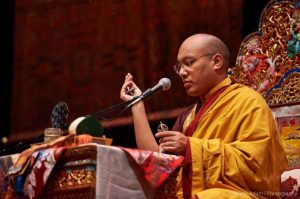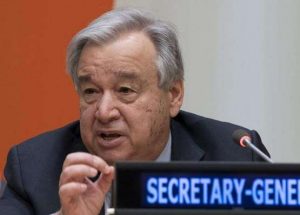The historical sketch of Buddhism in South Asia includes a presence belonging in India, Afghanistan, present-day Pakistan and Bangladesh. At various times in the history of these countries, Buddhists have experienced discrimination from non-Buddhists resulting in torture, execution, thrashing, and destruction of many Buddhist properties. More than a decade ago, the destruction of the Bamiyan Buddha-s shocked the modern world. Unfortunately, in the last year (September 2012) brutal destructions of Buddhist temples and houses continued to occur at Ramu in southeastern Bangladesh. Thousands of Muslim extremists torched more than twenty Buddhist temples, Buddha statues, ancient Buddhist manuscripts and homes in what is considered to be the worst attack on the Buddhist community since Bangladesh’s independence in 1971.
Violence was turned to Patiya in Chittagong district with vandalism inflicted in both Buddhist monasteries and Hindu temples. The following story is worth mentioning to illustrate an example of the atrocities: the Venerable Satyapriya Mahathero, 83 years old and one of the highest priests of Buddhists in Bangladesh, was oppressed in his temple during the violence. After taking an interview from the Venerable, The Daily Star journalists Inam Ahmed and Julfikar Ali Manik reported his personal account of the violence:
And yet he had to run for his life. When the mob attacked his monastery, his disciples held him on both sides, lifted him off the ground and carried him into the paddy field. That is where he hid the night and survived. With his deepest regret he said to them “My civilisation is lost. My lifetime of worshipping has gone in vain. I am a lost man and lost I will be. Even in 1971, I did not see this grotesque brutality on us. Muslim men and women had taken refuge in my monastery in 1971 to escape the wrath of the Pakistani army. I have saved so many Muslim souls from the brutal persecution of the Pakistanis. Today I feel defeated. Please save my future generation! Please!”(The Daily Star, Oct 02, 2012)
Fortunately, many people from different areas and Bangladesh government staff came forward to save remaining temples and houses from the extremists. Many of mediators, Buddhist monks, diplomats, politicians, humanists, social workers, professors, students and foreigners worked together to create a peaceful situation and interfaith harmony between the Muslims and Buddhists. Unfortunately, in areas of weak local government, the destruction rampages continued, particularly hard-hit in areas like Ramu where temples and houses burned down.
Active role by world media
On the morning of 30th September 2012, as usual I read the Bangladesh newspapers online. There on http://bdnews24.com/ was the news about the Ramu attack in a small column. Due to personal interest, immediately I phoned my relatives in Bangladesh to hear the news about Ramu. Throughout the day online, many media agencies covered the brutal attacks on Buddhists in Ramu. Day after day, the demonstrations and protests that came out impressed the world media and revealed the problems of minorities in Bangladesh. Bangladeshi Buddhists living in different countries such as United States, United Kingdom, Canada, France, Australia, Japan, India and Malaysia gathered together with local supporters and demonstrated in front of Bangladesh embassies, United Nations headquarters in New York and offices of international media centers. Additionally, large demonstrations were held in Buddhist countries like Sri Lanka, Thailand and Myanmar. Many Bangladeshi monks live in these other countries and play important roles with local monks and lay people. Thousand of monks and lay people protested in front of the Bangladesh embassy in Colombo, Sri Lanka. It was the largest protest outside of Bangladesh which the world media covered. Here are some example headlines:
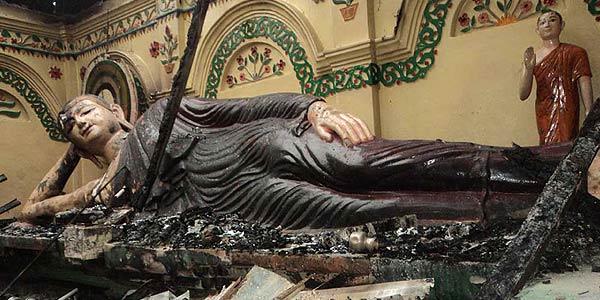
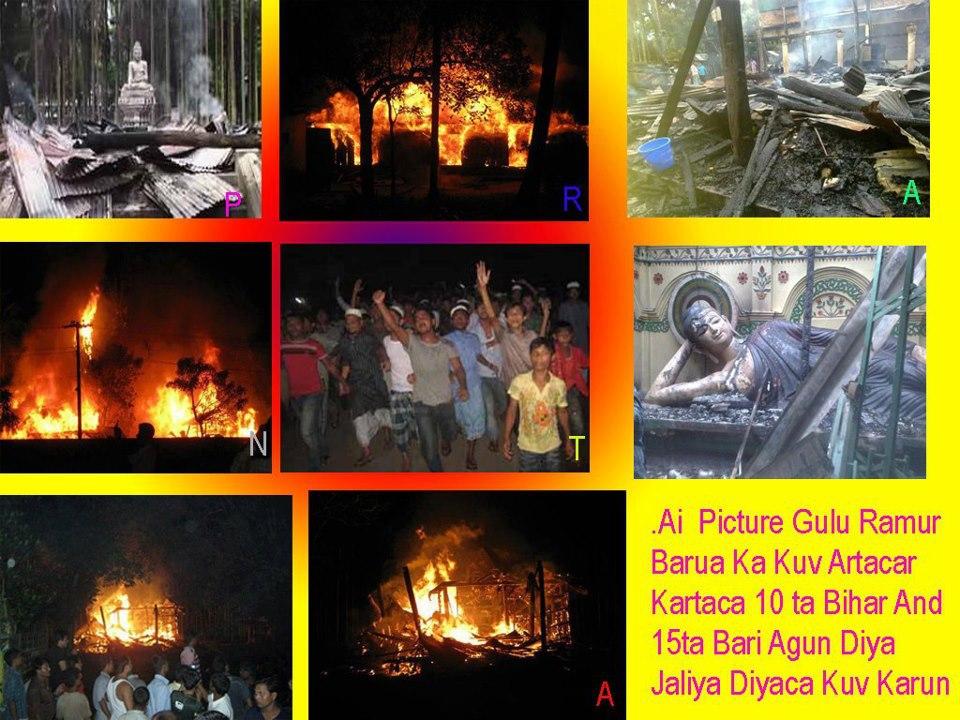
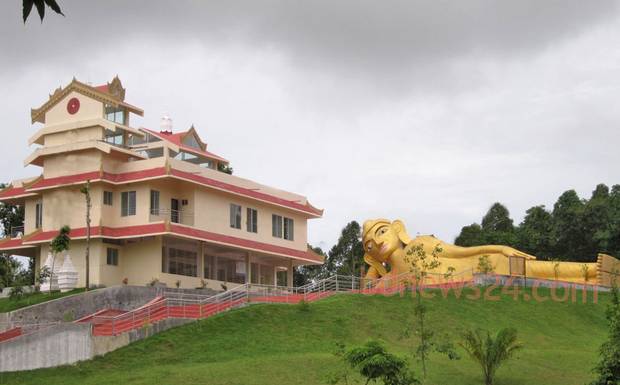
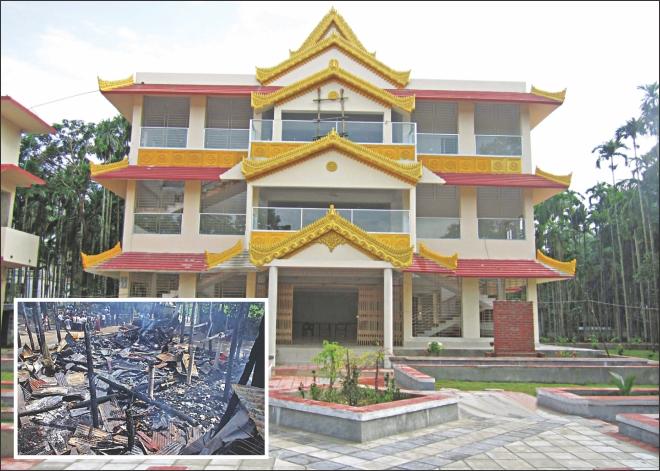
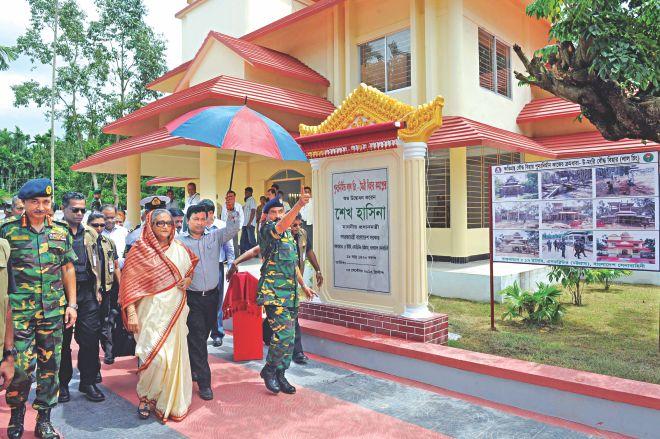
Protest in Sri-Lanka:
Voice of America: Sri Lanka’s Buddhist Monks Protest Bangladesh Violence – Hundreds of Buddhist monks demonstrated in Sri Lanka Thursday to protest a recent wave of violence targeting their religious community in Bangladesh.(Oct 04, 2012)
Z News: Buddhists protest in front of Bangladeshi mission in Lanka– Several Buddhist monks marched in front of the Bangladeshi High Commission here on Thursday to protest against the attacks on the community in that country.(Oct 04, 2012)
Protest in Thailand:
Voice of America: Thai Monks Rally Against Muslim Violence– About 200 monks marched peacefully in Bangkok, some carrying banners pleading for peace and harmony. Others carried posters demanding an end to what they called Muslim Terrorism against Bangladesh’s small Buddhist community.(Oct 03, 2012)
Singapore Press Website: 300 monks protest in Bangkok against anti-Buddhist attacks in Bangladesh – Holding signs reading No More Violence We Want Peace and Stop Muslim Terrorism on Bangladesh Buddhist, the monks from Bangladesh, Myanmar, Vietnam and Thailand massed outside the United Nation offices to call for a probe into the unrest.(Oct 03,2012)
Protest in Myanmar:
Chinese Newspaper Xinhua(English.com.cn): Myanmar Buddhist monks protest against Muslim extremist violence in Bangladesh – Myanmar Buddhist monks protest against Muslim extremist violence in Bangladesh – Dozens of Myanmar Buddhist monks gathered in front of the Bangladeshi Embassy here Friday and staged protest against recent Muslim extremists’ attacks on Buddhist institutions in Bangladesh.(Oct 05, 2012)
ABC Radio Australia: Burma’s monks protest violence in Bangladesh – Burma’s monks protest violence in Bangladesh – Hundreds of monks took to the streets of Burma’s Rakhine state capital Sittwe on Tuesday to protest against local Muslims and against violence targeting Buddhists in neighboring Bangladesh.(Oct 09, 2012)
Moreover, the Bangladesh media such as BBC Bangla, radio, television, newspapers and journals delivered praiseworthy reports supporting the victims as well as Buddhist community in Bangladesh. The English newspapers, especially The Daily Star, is highly appreciated for their liberal reports which provided a doorway to know the continuing situation. Apart from conventional news agencies, social media arenas like Facebook and Twitter helped facilitate news coverage in a widespread manner.
Meanwhile, the international communication agencies reported these significant events and delivered the unpleasant news to the rest of the world. All around the world, people kept their eyes on Bangladesh and voiced out against the Islamic fanatics. Thankfully, the Bangladesh government was motivated to save the minority. Global press agencies continued to run updates about the torched and looted sites and share the news worldwide.
Aljazeera – Protesters burn Bangladesh Buddhist temples. Sept 30, 2012
Google – Rioters torch Buddhist temples, homes in Bangladesh. Sept 30, 2012
International Business Times – Muslim Protesters Torch Buddhist Temples and Houses in Bang .Sept 30, 2012
Anorak – Bangladesh Buddhists attacked by outraged Muslims. Sept 30, 2012
Japan Today – Rioters torch Buddhist temples, homes in Bangladesh. Sept 30, 2012
Huffington Post World – Bangladesh: Muslims Attack Buddhist Temples, Homes Over Quran Face book Photo. Sept 30, 2012
The Blaze – Muslims Torch, Loot Buddhist Holy Sites in Bangladesh Over alleged facebook photo. Sept 30,2012
Bangkok Post – Rioters torch Buddhist temples, homes in Bangladesh. Sept 30, 2012
Voice of America – Bangladesh Accuses Rohingya Muslims of Attacking Buddhists. Oct 01, 2012
Australia Network News – Rioters torch Buddhist temples, homes in Bangladesh. Oct 01, 2012
The Australian News – Bangladesh vows to protect Buddhists. Oct 01, 2012
The Times of Israel – Thousands of Bangladeshi Muslims torch 10 Buddhist temples, 40 homes. Oct 01, 2012
Yahoo! News – Bangladesh says opposition attacked Buddhists .Oct 01, 2012
The Big Story – Bangladesh says opposition attacked Buddhists. Oct 01, 2012
The Hindu – Buddhists attacked in Bangladesh. Oct 01, 2012
CNN – Bangladesh Muslims torch Buddhist shrines, police say . Oct 01, 2012
Reuters – Bangladesh blames Muslim Rohingyas for temple attacks . Oct 01, 2012
Relief Web – 24 Buddhist and Hindu temples burnt in Bangladesh – India and UN urged to intervene. Oct 01, 2012
Global News – Bangladeshi Buddhists attacked. Oct 01,2012
Jakarta Globe – Bangladesh Says Opposition Attacked Buddhists. Oct 01, 2012
The Nation – Bangladesh deploys troops after attacks on Buddhists . Oct 02, 2012
Khabar South Asia- Bangladesh reels from attack on Buddhists . Oct 02,2012
First Post World – Bangladesh on high alert after attacks on Buddhists . Oct 02, 2012
One India News – Attack on Buddhists: Bangladesh govt raises alarm. Oct 02, 2013
Global Voice – Bangladesh: Ramu Attacks – A National Shame . Oct, 02, 2012
Dawn – Nearly 300 held in Bangladesh for attacks on Buddhists . Oct 02, 2012
The Indian Express – Bangladesh: Army in, 150 held after Buddhist temples torched. Oct 02, 2012
IBN Live – Bangladesh blames Muslim Rohingyas for attacks on Buddhist temples, 170 held . Oct 02, 2012
NDTV – Buddhists Attacked In Bangladesh . Oct 02 , 2012
The New Indian Express – Bangladesh put on alert after attacks on Buddhists. Oct 02, 2012
Z News – Opposition attacked Buddhists: Bangladesh . Oct 02, 2012
Hindustan Times – Nearly 300 held in Bangladesh for attacks on Buddhists. Oct 02, 2012
Times of India – Bangladesh police arrest 300 for attacks on Buddhist temples. Oct 02,2012
Lank Web – UK Buddhists protest against arson attacks on Buddhist temples villagers in Bangladesh. Oct, 06, 2012
Demotix – Indian Buddhists protest attacks on temples and homes in Bangladesh. Oct 08, 2012
Human Rights Defense International – Bangladesh Muslims attack Buddhists..burn temples
Apart from the above mentioned newspapers, other international media channels circulated breaking news in Bangladesh on Buddhist websites, organization websites, television, journals, blog posts and local newspapers – highlighting the attacks on minority Bangladesh Buddhists. As part of my daily work in Hong Kong, news links relevant to Bangladesh Buddhist, have been uploaded on Buddhistdoor International (http://www.buddhistdoor.com/eng), a large global Buddhist website. Additional, it is interesting to mention that the series of terrible attacks on Bangladesh Buddhist in September 2012 has its own Wikipedia entry: 2012 Ramu Violence. (http://en.wikipedia.org/wiki/2012_Ramu_violence)
Skillful works by the Bangladesh Government
After the dreadful attacks on the Bangladesh Buddhists, various religious minorities (besides Buddhists) in the country feared for their safety. Fortunately, the government of Bangladesh controlled the situation by developing extra security throughout the country. The Prime Minster, the opposition leader, government ministers and other administrative officers all unified to visit the damaged scenes. Financial assistance was immediately provided to the victims and initiatives taken to rebuild the monasteries and houses. The Prime Minister Sheikh Hasina called for punitive actions against the attackers and appealed to the people to maintain communal harmony in the country. The looted and vandalized temples were re-constructed by the Engineering Corps of 17 ECB Battalion in Cox’s Bazar of the Bangladesh Army. The government of Bangladesh has been highly praised for the speed and efficiency of rebuilding of Buddhist monasteries within one year of the attack. In the inauguration re-opening ceremony, thousands people of different religious traditions, politicians, diplomats and journalists gathered to honor the progress. The Prime Minster Sheikh Hasina called upon the people to protect religious and communal harmony in Bangladesh. Her outstanding invitation is a notable example in her words to the people:
The Ramu incident was a shame for all. The interfaith harmony, being nurtured for thousands of years, should be preserved at any cost.The situation was horrible and we could overcome it with united efforts of all. I always say religion is personal but festivals are for all. Peace, friendship and harmony are our pride.”(The Daily Star, Sept 04, 2013)
It was a shining highlight that ambassadors, commissioners and diplomats of the USA, Russia, India, Myanmar, Nepal, Sir Lanka, Bhutan, South Korea, China and Australia attended the inaugural ceremonies to show their support for Bangladesh to move forward in harmony. For these tremendous works, the government of Bangladesh was highly appreciated and their efforts recognized in these headlines:
UCANews.com – Bangladesh PM inaugurates 19 rebuilt temples. Sept 04, 2013
Xinhuanet(China) – Buddhists restore life after Muslims attack over Koran insult in Bangladesh. Sept 12, 2013
South China Morning Post – One year on, Bangladesh restores Buddhist temples destroyed in riots . Oct 01, 2013
After the Ramu Tragedy
What happened to the Buddhist community after the Ramu tragedy? Are they living happily in their country now? Obviously, the answer is no, because they are not necessarily free from communal danger and fear. Since the Ramu tragedy, many similar incidents have happened in other places. A Buddhist temple at Satkania in Chittagong district was set ablaze in February 2013. Two Buddhist temples at Patiya and Boalkhali in Chittagong district were looted and damaged in April 2013. Recently, (August 05, 2013) fresh violence occurred in Khagrachari of the Chittagong Hill tracts when two Buddhist temples were vandalized and five villages burned belonging to the indigenous people known as Chakma and Tripura. Unfortunately, as in the case of the Ramu attacks, the main instigators and perpetrators have not been arrested yet. There is an uneasy feeling that the government may be sheltering some of the suspects while innocent people are rounded up and blamed instead. Many victims are feeling fearful, angry and a lack of confidence in that some instigators may be involved in current government parties and thus protected from blame. For this reason, Buddhist people are urging a neutral investigation and asking for security to protect minorities. Venerable Satyapriya Mahathero, a senior monk in Bangladesh, says hopefully that:
It will allay the feelings of insecurity and lack of trust. Please, give us security. We’re a peace-loving people,”(The Daily Star, Sept 04, 2013).
However, the local people who are hunted, and Buddhist community of Bangladesh have expressed their sincere gratitude to the prime minister and the administration for rebuilding and renovation of the temples and rehabilitation of the victims. With thanks to the prime minister, it is hoped by the Buddhist community, that the administration will set up a permanent form of security for Buddhist monasteries and the local minority people.
In conclusion, it is with deepest regret to say that the motto of independent Bangladesh was not like today’s situation, where again and again communal atrocities occur. In the aftermath of the violence, government leadership is mired in blaming between political parties and this is the main setback for a secular administration. What is needed in Bangladesh is good governance, rule of law and social equality in order that minorities will not suffer any longer from torture, discrimination and danger in their lives. In recent times, the rise of Islamization and fanaticism leads to more peril for minorities in my beloved country. In this situation, we demand our fair rights as citizens, and mandatory protection and security from the government. Is that not what we all deserve with respect in our homeland of Bangladesh?




